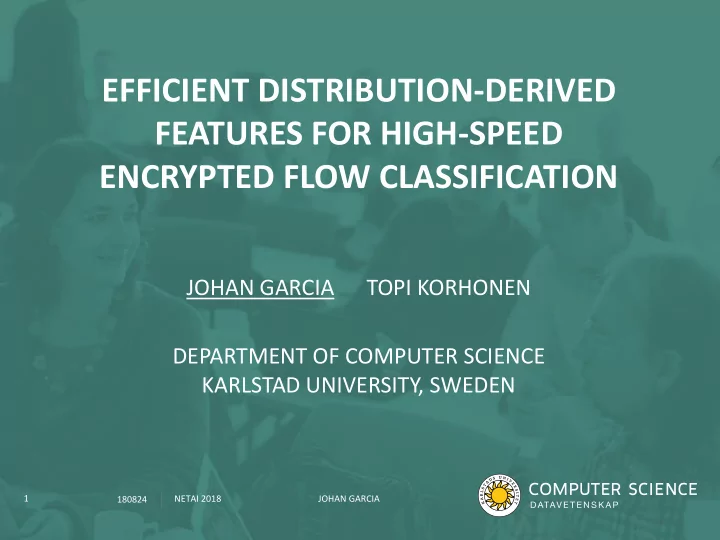

EFFICIENT DISTRIBUTION-DERIVED FEATURES FOR HIGH-SPEED ENCRYPTED FLOW CLASSIFICATION JOHAN GARCIA TOPI KORHONEN DEPARTMENT OF COMPUTER SCIENCE KARLSTAD UNIVERSITY, SWEDEN 1 180824 NETAI 2018 JOHAN GARCIA
PRESENTATION OUTLINE • Problem formulation and specifics • Distributional attributes • The KSD approach for discretization • Synthetic dataset evaluation • Empirical dataset evaluation • Conclusions and observations Thanks to: 2 180824 NETAI 2018 JOHAN GARCIA
PROBLEM FORMULATION • Flow classification is useful to ensure efficient network resource usage and support QoE • Traffic is increasingly becoming encrypted by default • Flow classification based on traditional Deep packet inspection (DPI) becomes unfeasible with encrypted flows • Machine Learning on content-independent traffic characteristics can be used for classification of encrypted flows • A subset of features used for classification are distribution-derived • Q: How can we best describe distribution-derived features? 3 180824 NETAI 2018 JOHAN GARCIA
PROBLEM SPECIFICS Target use case • Flow level (i.e. 5-tuple) characterization, not session level • Focus on early flow classification: <=50 packets • High speed: Up to 1 million flows per second in one box J Garcia, T Korhonen, R Andersson, F Västlund. Towards Video Flow Classification at One Million Encrypted Flows per Second. IEEE AINA 2018 4 180824 NETAI 2018 JOHAN GARCIA
Distributional attributes 5 180824 NETAI 2018 JOHAN GARCIA
DISTRIBUTIONAL ATTRIBUTES OF FLOWS • Distributional attributes of N first packets of a flow: • Packet sizes • Interarrival times • Burst-lengths (in seconds and/or bytes) • Inter-burst lengths (in seconds) • Distributional feature descriptors: • Basic: Min/mean/max • Moments-based: Standard deviation, variance, skew, kurtosis • Histogram based: Linear, Probabilistic, MDLP, or KSD discretization • Bin-boundary placement, i.e. discretization, quantization, multi- splitting, … • Different discretization goals: • Encoding a scalar value • Describing a distribution • Maximizing the discriminative power between two distributions 6 180824 NETAI 2018 JOHAN GARCIA
DESCRIBING DISTRIBUTIONAL ATTRIBUTES A mixture of Gaussian distribution (gray), and a mixture of Beta distributions (blue) 7 180824 NETAI 2018 JOHAN GARCIA
DESCRIBING DISTRIBUTIONAL ATTRIBUTES A mixture of Gaussian distribution (gray), and a mixture of Beta distributions (blue) STATISTICAL MOMENTS MAY NOT ALWAYS CAPTURE THE FULL DISTRIBUTIONAL DIFFERENCE 8 180824 NETAI 2018 JOHAN GARCIA
KSD Kolmogorov-Smirnov Discretization 9 180824 NETAI 2018 JOHAN GARCIA
KSDALGORITHM EXAMPLE • PDF of two Gaussian mixtures • CDF 10 180824 NETAI 2018 JOHAN GARCIA
KSDALGORITHM EXAMPLE • Add text and formulas from LyX screeshot 11 180824 NETAI 2018 JOHAN GARCIA
LINEAR VS KSD BINNING OF PACKET SIZE DISTRIBUTIONS 12 180824 NETAI 2018 JOHAN GARCIA
Synthetic evaluation 13 180824 NETAI 2018 JOHAN GARCIA
SYNTHETIC EVALUATION APPROACH • Discretization: Linear, probabilistic, MDLP, KSD, KSD_NMDLP • Distribution separation evaluation metric: Jensen-Shannon distance, Chi2, Kullback Leibler-divergence • Random forest classification evaluation metric: ROC-AUC • Number of runs for JSD (Random forest) evaluation: 1000 (200) Realizations of distribution mixtures 12 (5) instantiation of different nr of samples 12-5000 (10-100) • 14 180824 NETAI 2018 JOHAN GARCIA
JENSEN-SHANNONDISTANCE OF DISCRETIZERS • MDLP & KSD_NMDLP best (but have more bins) • KSD better than LIN and PROB in most cases for same bin nr • The more complex distribution (i.e Beta mixtures) gives larger difference 15 180824 NETAI 2018 JOHAN GARCIA
RANDOM FOREST CLASSIFICATION ON SYNTHETIC DATA • More samples (packets) give better performance • Ba+mo (moments) consistently bad • More complex distributions give worse performance 16 180824 NETAI 2018 JOHAN GARCIA
Empirical evaluation 17 180824 NETAI 2018 JOHAN GARCIA
DATA COLLECTION • Data collected by specially instrumented commercial DPI HW inside live cellular network during Feb 2017 • Per-packet data and flow classification labels (i.e ground-truth) collected for first 60 seconds of each flow • 2.1B packets / 834M packets after filtering / 10M flows • Set of Video and VoIP application labels provided by DPI vendor • Per-flow features were computed based on this per-packet data 18 180824 NETAI 2018 JOHAN GARCIA
FEATURES USED IN EVALUATION • Four feature groups: fa : Flow attributes – Non-distributional flow features ba : Basic statistics – Basic distribution-derived features mo : Statistical moments – Extended distribution-derived features bn : Histogram-based features – using a specific discretization method 19 180824 NETAI 2018 JOHAN GARCIA
ACCURACY RESULTS 22 180824 NETAI 2018 JOHAN GARCIA
ACCURACY RESULTS 23 180824 NETAI 2018 JOHAN GARCIA
ACCURACY RESULTS Adap KSD best 24 180824 NETAI 2018 JOHAN GARCIA
ACCURACY RESULTS Adap KSD best Early optimum Metric matters 26 180824 NETAI 2018 JOHAN GARCIA
ACCURACY RESULTS Adap KSD best Early optimum Metric matters Fraction matters 27 180824 NETAI 2018 JOHAN GARCIA
CONCLUSIONS AND OBSERVATIONS • Histogram-based distribution-derived features improves on statistical moments by achieving: • Better classification performance • Better run-time performance, i.e. lower computational complexity • Allows for a flexible choice in the number of feature descriptors • Among the evaluated histogram discretization approaches: • Adaptive KSD performs best with MDLP quite close • KSD is designed to allow a flexible number of bins, and has lower (offline) computational complexity • Linear and probabilistic discretization falter. • Nr of initial packets have a noticeable impact on classification performance. • JSD distance, simulated RForest, and empirical RForest differ (un)expectedly 28 180824 NETAI 2018 JOHAN GARCIA
Recommend
More recommend